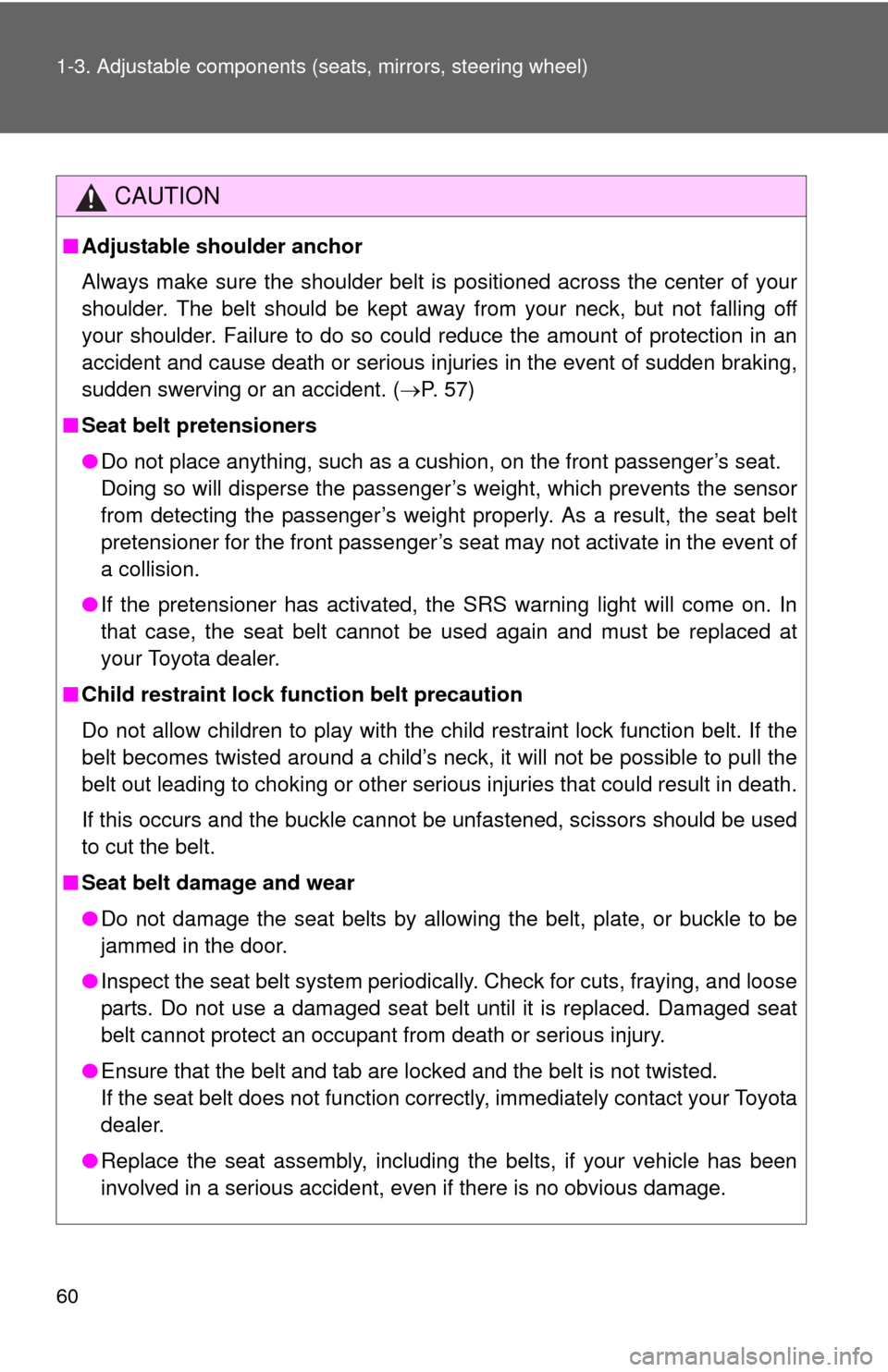Page 60 of 528

60 1-3. Adjustable components (seats, mirrors, steering wheel)
CAUTION
■Adjustable shoulder anchor
Always make sure the shoulder belt is positioned across the center of your
shoulder. The belt should be kept away from your neck, but not falling off
your shoulder. Failure to do so could reduce the amount of protection in an
accident and cause death or serious injuries in the event of sudden braking,
sudden swerving or an accident. ( P. 57)
■ Seat belt pretensioners
●Do not place anything, such as a cushion, on the front passenger’s seat.
Doing so will disperse the passenger’s weight, which prevents the sensor
from detecting the passenger’s weight properly. As a result, the seat belt
pretensioner for the front passenger’s seat may not activate in the event of
a collision.
● If the pretensioner has activated, the SRS warning light will come on. In
that case, the seat belt cannot be used again and must be replaced at
your Toyota dealer.
■ Child restraint lock function belt precaution
Do not allow children to play with the child restraint lock function belt. If the
belt becomes twisted around a child’s neck, it will not be possible to pull the
belt out leading to choking or other serious injuries that could result in death.
If this occurs and the buckle cannot be unfastened, scissors should be used
to cut the belt.
■ Seat belt damage and wear
●Do not damage the seat belts by allowing the belt, plate, or buckle to be
jammed in the door.
● Inspect the seat belt system periodically. Check for cuts, fraying, and loose
parts. Do not use a damaged seat belt until it is replaced. Damaged seat
belt cannot protect an occupant from death or serious injury.
● Ensure that the belt and tab are locked and the belt is not twisted.
If the seat belt does not function correctly, immediately contact your Toyota
dealer.
● Replace the seat assembly, including the belts, if your vehicle has been
involved in a serious accident, even if there is no obvious damage.
Page 63 of 528
63
1
1-3. Adjustable components (seats, mirrors, steering wheel)
Before driving
Anti-glare inside rear view mirror
Adjusting the height of rear view mirrorAdjust the height of the rear view
mirror by moving it up and down.
In automatic mode, sensors are u sed to detect the headlights of
vehicles behind and automatically reduces the reflected light.
Turns automatic mode on/off
The indicator comes on when
automatic mode is turned on.
The mirror will revert to the
automatic mode each time the
engine switch is turned on.
Page 64 of 528
64 1-3. Adjustable components (seats, mirrors, steering wheel)
■To prevent sensor error (veh icles with auto anti-glare inside rear view
mirror)
■ If a sun visor inte rferes with the mirror
CAUTION
■Caution while driving
Do not adjust the position of the mirror while driving.
Doing so may lead to mishandling of the vehicle and an accident, resulting in
death or serious injury.
To ensure that the sensors operate prop-
erly, do not touch or cover them.
Hold and rotate the mirror to adjust the
support.
Page 80 of 528
80 1-7. Safety information
Airbag system componentsFront passenger airbag
Curtain shield airbags
Side airbags
Occupant detection system
(ECU and sensors)
Front passenger’s seat belt
buckle switch
SRS warning light and
RSCA OFF indicator light
Curtain shield airbag sen-
sors Side and curtain shield air-
bag sensors
Driver airbag
RSCA OFF switch
Driver’s seat position sen-
sor
Driver’s seat belt buckle
switch
AIR BAG ON and AIR BAG
OFF indicator lights
Airbag sensor assembly
Front airbag sensors
Page 81 of 528

81
1-7. Safety information
1
Before driving
Your vehicle is equipped with
ADVANCED AIRBAGS designed based
on US motor vehicle safety standards (FMVSS208). The airbag sys-
tem controls airbag deployment po wer for the driver and front pas-
senger. The driver airbag system consists of the driver seat’s position
sensor etc. The front passenger’s airbag system consists of the front
passenger occupant classification sensor etc.
The main SRS airbag system components are shown above. The
SRS airbag system is controlled by the airbag sensor assembly. The
airbag sensor assembly consists of a safing sensor and an airbag
sensor.
In certain types of severe frontal or side impacts, the SRS airbag sys-
tem triggers the airbag inflators. A chemical reaction in the inflators
quickly fills the airbags with non-toxic gas to help rest rain the motion
of the occupants.
■ SRS warning light
This warning light system monitors the airbag sensor assembly, front airbag
sensors, side and curtain shield airbag sensor assemblies, curtain shield air-
bag sensor assemblies, driver’s seat position sensor, driver’s seat belt
buckle switch, front passenger occupant classification system, AIR BAG ON
indicator light, AIR BAG OFF indicator light, front passenger’s seat belt
buckle switch, seat belt pretensioner assemblies, RSCA OFF indicator light,
inflators, interconnecting wiring and power sources. ( P. 431)
■ If the SRS airbags deploy (inflate)
●Bruising and slight abrasions may result from contact with a deploying
(inflating) SRS airbag.
● A loud noise and white powder will be emitted.
● Parts of the airbag module (steering wheel hub, airbag cover and inflator)
as well as the front seats, and parts of the front and rear pillars and roof
side rail, may be hot for several minutes. The airbag itself may also be
hot.
● The front windshield may crack.
Page 152 of 528
152
2-4. Using other driving systems
Intuitive parking assist
: If equipped
The intuitive parking assist assists the driver by communicating the
distance to obstacles measured by the sensors via the buzzer when
parallel parking or maneuvering into a garage. Always check the sur-
rounding area when using this system.
■ Back sensors
These sensors detect obsta-
cles behind the vehicle.
Page 153 of 528
153
2-4. Using other
driving systems
2
When driving
The distance and buzzer
When a sensor detects an obs tacle, the buzzer sounds.
■Intuitive parking assist switch
ON/OFF
When on, the buzzer sounds
to inform the driver that the
system is operational. At this
time, the indicator will come
on.
Press the switch to switch the
ON/OFF mode.
Distance shown
as 4.9 to 3.3 ft.
(150 to 100 cm)3.3 to 1.6 ft.
(100 to 50 cm)1.6 ft.
(50 cm)
BuzzerMedium Fast Continuous
Page 154 of 528
154 2-4. Using other driving systems
Sensors that operate and detection rangeThe following diagrams show the sensor detection range. Note that
sensors may not be able to detect obstacles that are extremely close
to the vehicle.
■ Detection range of the sensors
Approx. 4.9 ft. (150 cm)
The diagram shows the detection
range of the sensors. Note that
the sensors may not be able to
detect obstacles that are
extremely close to the vehicle.
The range of the sensors may
change depending on the shape
of the object etc.